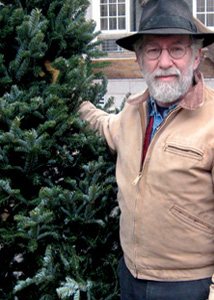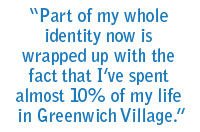 Since 1988 Vermonter Billy Romp and his family have been selling Christmas trees at the corner of Jane Street and Eighth Avenue, forging lifelong friendships with neighborhood residents through the years. Their story has been immortalized in a book entitled “Christmas on Jane Street” by Romp and Wanda Urbanska
Since 1988 Vermonter Billy Romp and his family have been selling Christmas trees at the corner of Jane Street and Eighth Avenue, forging lifelong friendships with neighborhood residents through the years. Their story has been immortalized in a book entitled “Christmas on Jane Street” by Romp and Wanda Urbanska
and is available for purchase at the stand.
For Billy Romp and his family, their annual pilgrimage to the West Village to sell Christmas trees is framed around a desire to see old friends, make new ones, and—above all—offer the best customer service in town. “Everybody’s got nice trees on the corner,” Romp says. “If we’re going to distinguish ourselves, it’s with our retail excellence and customer service. We like to think that no one will go further than us. I may look like a hick out there, but we treat this as a serious business.”
Born in upstate Troy, Romp moved to Vermont in the 1970s “with all the other back-to-the-land hippies.” And how did the current tradition get started? “My wife Patti and I were looking for another thing to add to our annual income,” Romp recalls. “We heard of a friend who had gone down to New York City to sell trees and made better money than by doing it in Vermont. Then we talked to other people who had done it, including a tree wholesaler who mentioned that Jane Street was available. My knowledge of Greenwich Village was pretty slim then. All I knew is that it had gay people and actors! So we came down, expecting nothing. We just hoped we could survive and make a few dollars.”
So what’s it been like? “It’s been life-changing,” Romp enthuses. “Part of my whole identity now is wrapped up with the fact that I’ve spent almost 10% of my life in Greenwich Village. The relationships I have with the people I’ve met down here are the most important part of the whole thing. The money is great and the experience is great. But it’s the people I’ve befriended that have made the biggest difference in my life. I can’t think of another mechanism where we could’ve met such a broad range of people so different from ourselves”
 As someone who only visits yearly, Romp is in a particularly good position to observe changes to the neighborhood. “The gentrification is really obvious to me,” he says. “I’m on the street and I can see the changes right away. When we first came here, the transvestites and hookers from the meat market would spill over into the neighborhood. I saw crack vials on the corner of Jane Street those first couple of years. I saw violence as well. And I’ve seen what everyone else has seen: the general cleaning up of the neighborhood.” Romp continues. “I could talk about the physical changes but I also want to emphasize that there are a lot of people walking their dogs who were here in 1988. However, many of them worry that they will have to leave one day because they can’t afford the area anymore, particularly the renters. A lot of them are afraid of their landlord because they know that he wants them to leave.”
As someone who only visits yearly, Romp is in a particularly good position to observe changes to the neighborhood. “The gentrification is really obvious to me,” he says. “I’m on the street and I can see the changes right away. When we first came here, the transvestites and hookers from the meat market would spill over into the neighborhood. I saw crack vials on the corner of Jane Street those first couple of years. I saw violence as well. And I’ve seen what everyone else has seen: the general cleaning up of the neighborhood.” Romp continues. “I could talk about the physical changes but I also want to emphasize that there are a lot of people walking their dogs who were here in 1988. However, many of them worry that they will have to leave one day because they can’t afford the area anymore, particularly the renters. A lot of them are afraid of their landlord because they know that he wants them to leave.”
When asked what he thinks some of the challenges facing the West Village these days are, Romp deliberates for a moment. “I think it would be the challenge of cohesiveness,” he ventures. “There are a few people who are really interested in keeping the community together. However, I fear these activists are smaller in number than they used to be so it seems that the same people are carrying the load. I just hope it’s a big enough number to keep this neighborhood’s character preserved. In my opinion, there’s nothing at all like the West Village.”
It’s that character that fosters the special ties Romp has with his customers, some of them generational now. “There’s one particular family that I’ve been delivering a tree to and setting it up for 22 years,” he relays. “The family’s little girl that I met 22 years ago now has her own apartment on Jane Street and her own baby, and I’m setting up their tree as well. If things go as planned, my sons will be setting up the tree for her little girl when I’m an old man. There’s a wonderful continuity to this relationship with our clients. They treasure it. I treasure it. You couldn’t ever replace it.”
Photo: Maggie Berkvist
